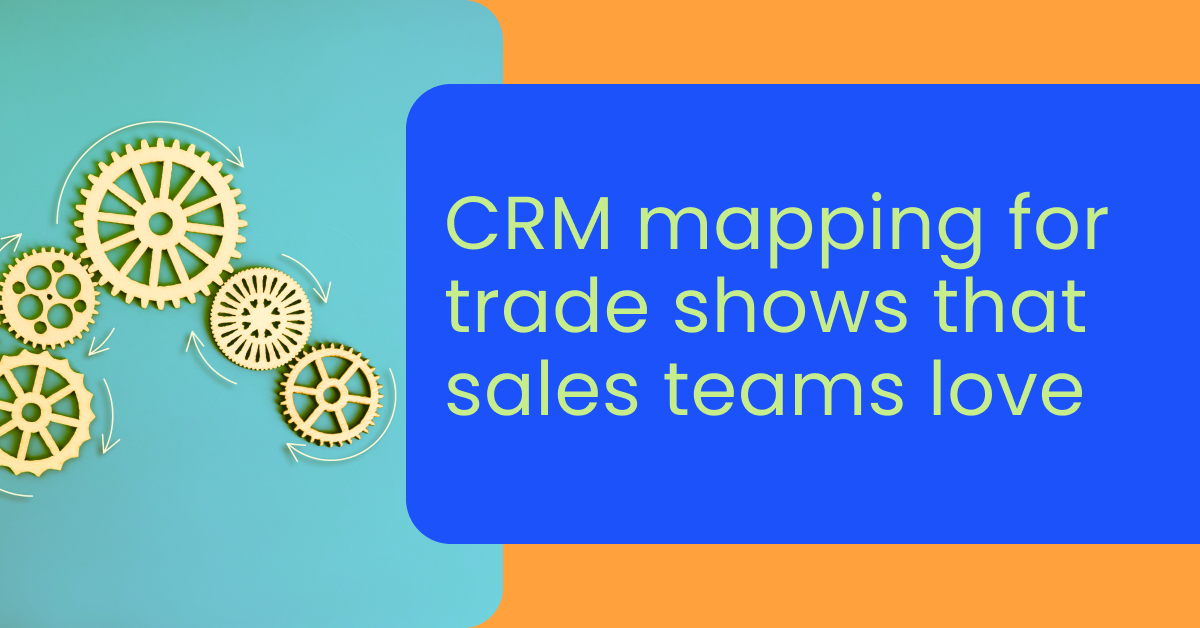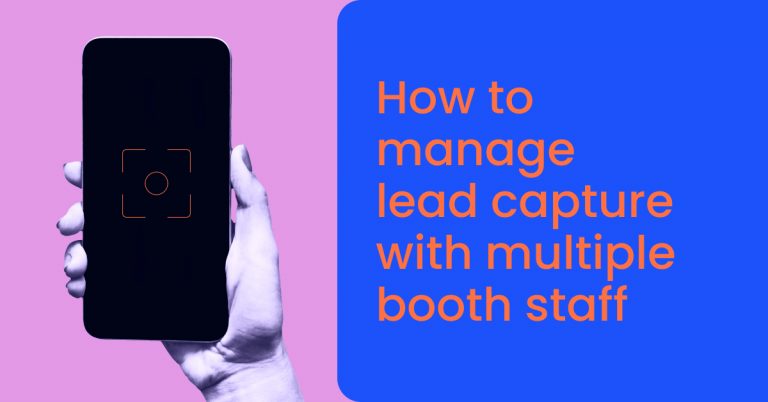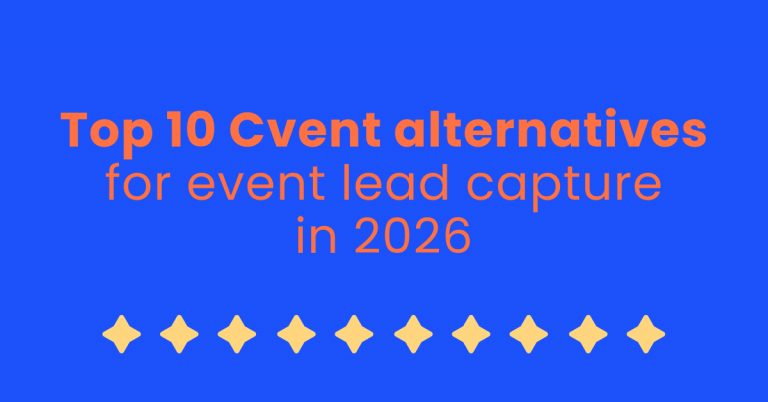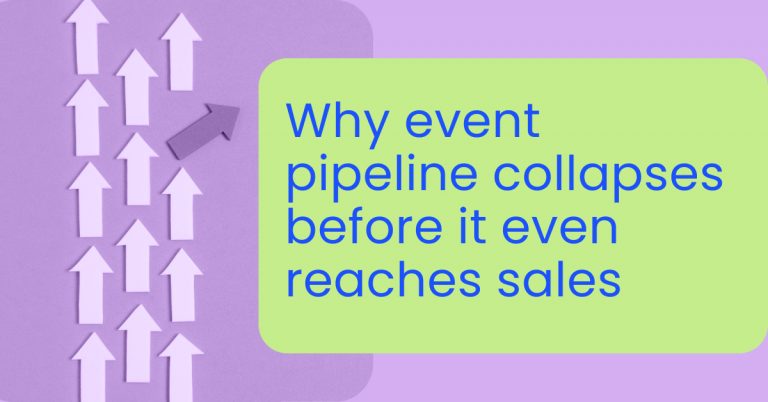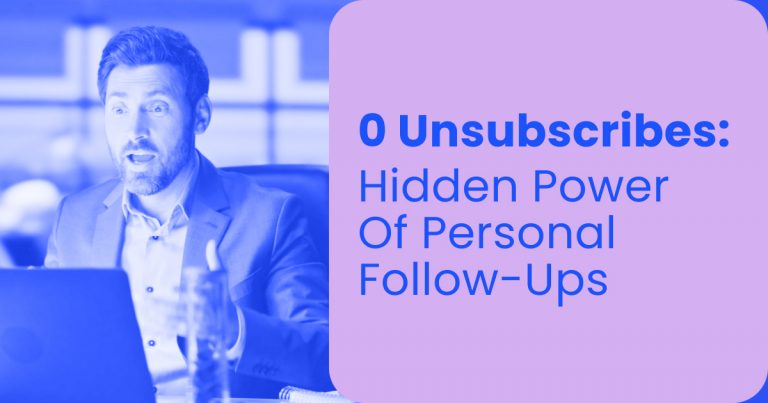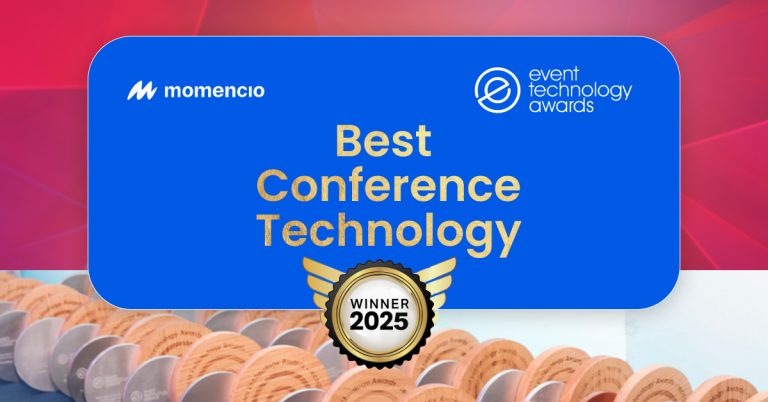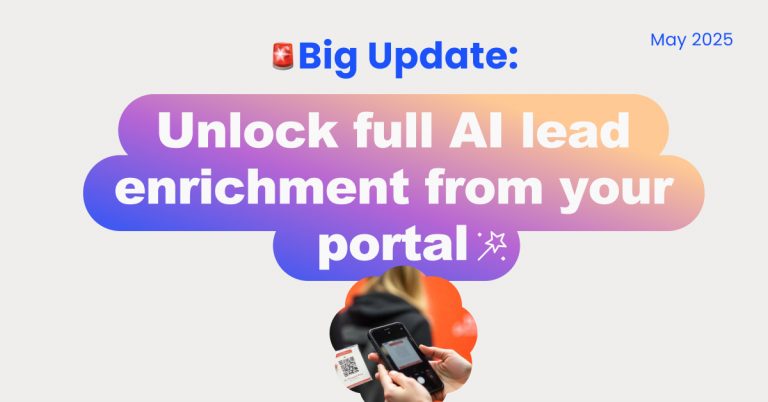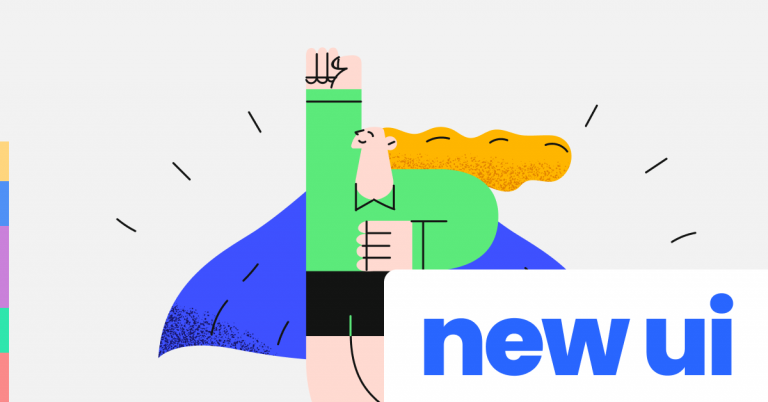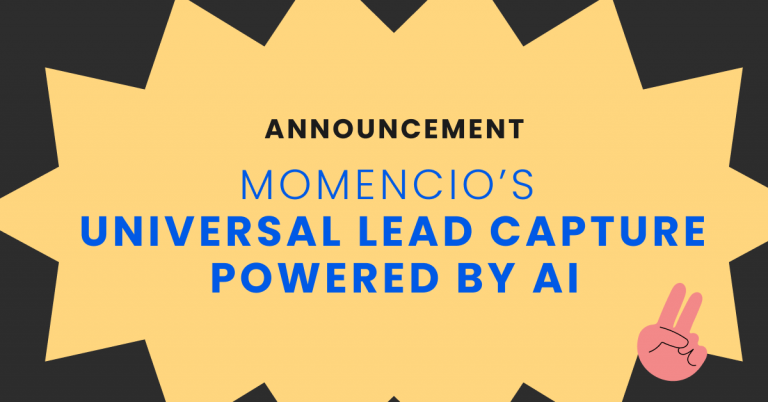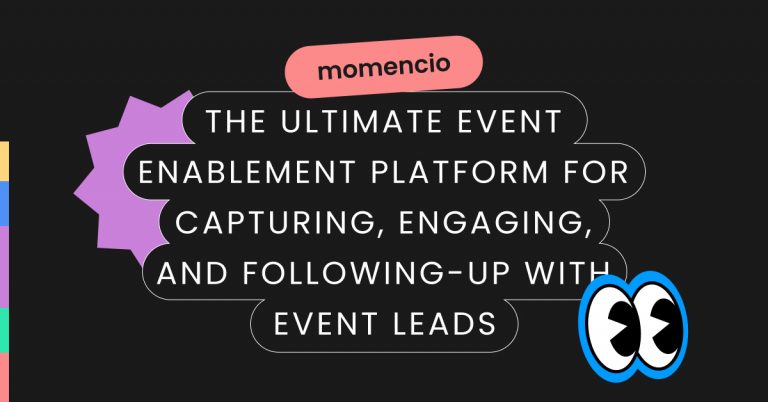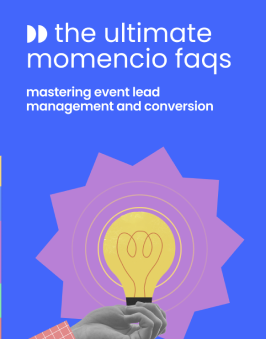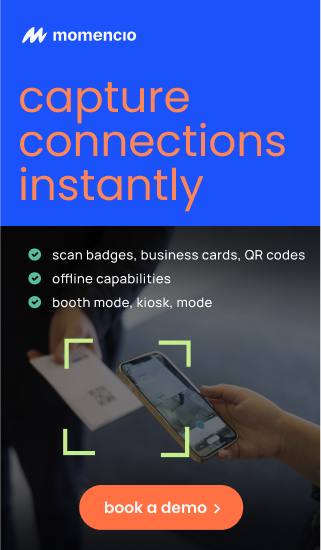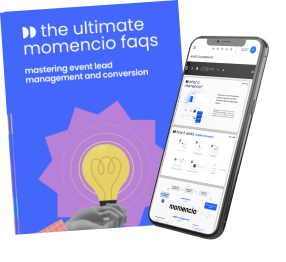This article explains how to map data that momencio captures at events into your CRM so records carry usable context for sales. It will specify which CRM objects and fields to use, and show example triggers for tasks and follow-ups. No new tools are required. We are using momencio’s existing capabilities and standard CRM features.
momencio provides the relevant signals for this mapping: IntelliStream records scans and other interactions in real time, with a unified view across contacts and sessions. LiveMicrosite creates a unique, per-lead link that can be updated after sending and it tracks engagement. AI EdgeCapture scans badges or business cards and can enrich data before sync. Event Dashboards show live activity. The Salesforce integration supports bidirectional sync and includes a momencio score field.
What follows is a step-by-step mapping of those signals into CRM objects and fields, plus simple automation examples. We will use Leads or Contacts, Campaigns and Campaign Members, and Activities, then add a narrow set of fields for score, intent, asset engagement, and timing.
Why syncing leads isn’t enough
Syncing badge scans or lead lists from a trade show into a CRM is only the first step. Once the names are in the database, most CRMs don’t include the rich context that happened at the booth — which demo they watched, what questions they asked, whether they returned to your microsite, or how interested they appeared.
momencio already captures that information: it tracks every badge scan and interaction in real time through IntelliStream, it records content engagement through LiveMicrosite, and it enriches badge or card data with AI EdgeCapture. All of this can be synced automatically to Salesforce and other CRMs.
The gap is not in capturing data but in how the data appears once it lands in the CRM. Without the right field mapping and workflow rules, your sales team may only see a name and email, not the intent signals or urgency flags that momencio generated. This article explains how to bring that context into your CRM so leads arrive ready for action instead of sitting as static records.
What momencio already does for you
momencio already collects and organizes far more than just badge scans. These are the key capabilities that are relevant for CRM mapping:
- IntelliStream records every badge scan and other booth interactions in real time. It stitches those touchpoints together so you see a complete view of each person’s journey across your booth or sessions.
- LiveMicrosite generates a unique, personalized link for each lead that can be updated after it’s sent. It streams back exactly what the person viewed or clicked so you know their interests.
- AI EdgeCapture scans badges or business cards and enriches the data on the spot, even without access to the event organizer’s API.
- Event dashboards show live activity during the show, giving your team visibility into traffic, engagement, and lead status in real time.
- CRM integrations with platforms like Salesforce and HubSpot support bidirectional sync. These integrations carry momencio’s engagement scores and urgency signals directly into the CRM so sales teams see them alongside the contact record.
This means you already have everything needed to know who visited your booth, what they did, and how interested they are. The next step is to make sure this information arrives in your CRM in a way that your sales team can use immediately.
Mapping momencio signals into CRM actions
Once momencio has captured and scored your leads, the next step is to make sure those signals show up inside your CRM in a way your sales team can act on. This doesn’t mean creating new systems or setting up complicated scoring rules — momencio already does the heavy lifting. It simply means creating the right fields and workflows in your CRM so the context travels with each lead.
Here are the core elements to map:
- Engagement score and urgency: Add fields for momencio Score and Urgency Flag on each lead or contact. This lets sales reps see at a glance how engaged someone was at your booth.
- Intent and role: Create small, clear picklists (for example: Primary Intent, Buying Role, Topic of Interest). These values can be fed automatically from momencio so your team can filter and prioritize leads without reading through notes.
- Journey details: Map momencio’s IntelliStream data into CRM objects your team already uses. In Salesforce or HubSpot this can be Campaigns/Campaign Members or Activities. This gives a timeline of what the person did before and during the event.
- Microsite engagement: Store the unique LiveMicrosite link plus the date of last visit and last asset viewed. This lets reps tailor their follow-up to what the lead actually looked at.
- Routing and response timers: Use your CRM’s built-in automation to create tasks automatically. For example, when a lead’s score is high and the urgency flag is true, assign a task to a rep with a 2-hour response time. If there’s no action, reassign or notify a manager.
- Content attribution: Add fields for “Last Asset Viewed” or “Asset Sequence” so marketing can see which pieces of content lead to meetings or deals.
- Data hygiene and offline capture: Define a simple duplicate rule: email is the golden record, then company + name + phone as backup.
By mapping these elements, every lead that arrives in your CRM carries not just contact details but the context, priority and next steps your team needs to act fast.
Building a real-time follow-up engine
momencio already captures each visitor’s details and behavior at your booth and can pass that information to your CRM as it happens. With the right field mapping from Section 4, you can turn this live data into immediate follow-up actions without adding new software.
Here’s how it works in practice:
- When a lead is scanned and marked with a high momencio Score and an Urgency Flag, a task can be created automatically in Salesforce or HubSpot and assigned to the right sales rep.
- The task can include the lead’s key details — what they looked at on the microsite, which demo they visited, and any notes your rep added on the spot — so the rep knows exactly how to follow up.
- You can set a response time (for example, two hours) and have the CRM send reminders if no action is taken. This keeps hot leads from cooling off.
- If the person re-engages with the microsite after the show, the CRM can create a new task or trigger a “revive” sequence without anyone manually checking reports.
Because momencio streams data continuously, this system lets you act on leads while interest is still high instead of days later. The result is faster responses and better conversion of event leads into real opportunities.
Closing the loop: content and asset attribution
| Typical situation | With momencio + CRM mapping |
| Leads show up in the CRM with only name and contact details. Marketing can’t tell which booth assets worked. | momencio tracks which videos, PDFs, or demos each visitor engaged with (via LiveMicrosite and IntelliStream) and passes that into fields like “Last Asset Viewed” or “Asset Sequence” in Salesforce or HubSpot. |
| Reps send generic follow-ups after the event. | Reps see exactly what a person viewed and can tailor the follow-up to that interest. |
| Marketing reports on total scans but can’t link content to pipeline. | Campaign Member reports in the CRM can include asset fields so you can measure which content or booth experience led to meetings, opportunities, or revenue. |
This simple field mapping turns anonymous “booth engagement” into clear evidence of what drove results. It also helps marketing know which assets to invest in for future events and lets sales follow up with precision instead of guesswork.
Data hygiene and offline safety net
At any event, it’s easy to end up with duplicate or incomplete records when data moves from a lead-capture tool into a CRM. To avoid that, establish a few simple practices before and after the show:
- Choose a primary identifier – treat email as the key field when records are created or updated.
- Fallback match – if email is missing, match on company plus full name to prevent duplicates.
- Minimal required fields – make sure every capture includes at least first name, last name, and company so later enrichment or follow-up is possible.
- Offline capture policy – if your team is scanning when Wi-Fi is poor, confirm that the app buffers data locally and syncs automatically when back online.
- Post-event verification – after the event, run a quick reconciliation between the number of leads captured and the number in your CRM, and spot-check key fields.
These simple steps keep the data your team collects at the booth accurate and complete when it reaches Salesforce, HubSpot or any other CRM.
Dashboards and visibility
momencio includes live dashboards that give you a clear view of what’s happening at your booth while the event is still running. These dashboards show, in real time, which visitors have been scanned, what content they engaged with, which meetings were booked, and each lead’s engagement score and urgency flag. Nothing extra needs to be built — it’s part of the platform.
To make that information useful after the event, mirror the key dashboard metrics inside your CRM. Use standard objects such as Campaigns, Campaign Members and Activities in Salesforce or HubSpot to carry over data like engagement score, urgency, last microsite visit, assets viewed and meeting scheduled at the booth. This way the same data your team saw live at the show is sitting in the lead record they’ll work on later.
This approach creates continuity: managers can see at a glance which leads are hot, which reps have acted and which opportunities are moving. It also makes reporting on event ROI straightforward, because the very same data captured on the show floor flows directly into your pipeline and revenue reports.
A simple event blueprint checklist (Printable)
| Stage | What to check | What to do | Why it matters |
| Pre-event | Make sure the momencio integration with your CRM is active and the standard fields are already syncing. | Run a small test scan and see the fields appear in your CRM. | Confirms everything flows correctly before the show starts. |
| During event | Use momencio to scan leads and add quick notes or tags. Watch the live dashboard for hot leads and meetings. | Respond fast to high-score or urgent leads. Let tasks create automatically in Salesforce or HubSpot. | Acts while interest is highest. |
| Post-event (Day 1-3) | Allow momencio’s lead enrichment to fill empty CRM fields. Compare number of leads captured with number in your CRM. | Spot-check a few records for score, urgency, last microsite visit and last asset viewed. Merge any duplicates. | Keeps records complete and usable for follow-up. |
| Post-event (Week 1+) | Use CRM views that mirror momencio metrics to track rep actions and pipeline movement. | Launch follow-up sequences based on score, urgency and content viewed. Managers review response times and meetings set. | Turns captured leads into measurable opportunities and shows ROI clearly. |
Turning the plan into action
You now have a full blueprint for turning raw event scans into active opportunities inside your CRM. By using momencio’s built-in scoring, enrichment and dashboards, and by following simple hygiene checks and follow-up rules, your team can leave a show with leads that are already prioritized, enriched and ready for outreach — not a pile of partial records waiting to be cleaned.
The easiest way to put this into practice is to run a small dry run before your next event: test the integration with Salesforce and HubSpot, confirm the fields show correctly, and walk your reps through the one-page checklist. Once the show starts, you’re not building workflows on the fly — you’re simply executing a plan that works.
If you’d like to see how these steps look end-to-end, you can point readers to momencio’s demo page or the specific product pages (IntelliStream, LiveMicrosite, AI EdgeCapture) as additional resources. That gives them a direct path to replicate what you’ve described without adding fluff or a hard sales pitch.
